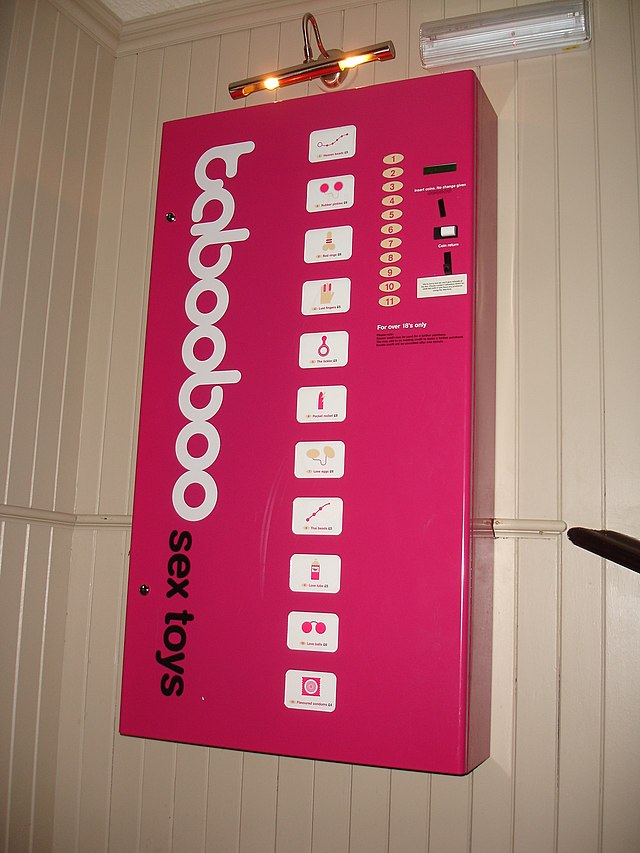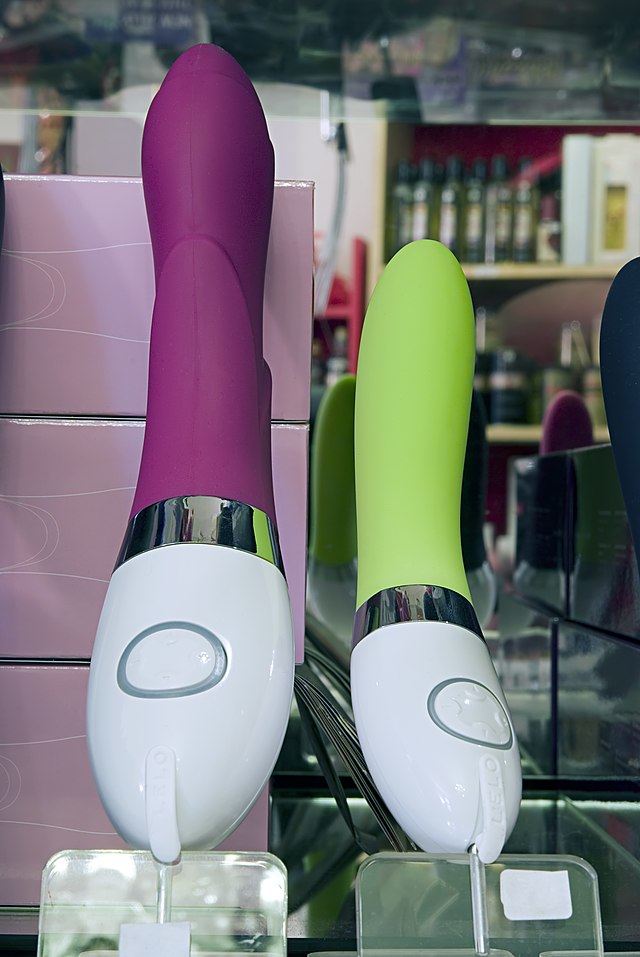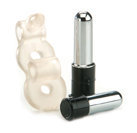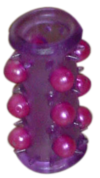Loading AI tools
Sexual pleasure device From Wikipedia, the free encyclopedia
A sex toy is an object or device that is primarily used to facilitate sexual pleasure, such as a dildo, artificial vagina or vibrator.[1] Many popular sex toys are designed to resemble human genitals, and may be vibrating or non-vibrating. The term sex toy can also include BDSM apparatus and sex furniture such as sex swings; however, it is not applied to items such as birth control, pornography, or condoms. Alternative terms for sex toy include adult toy and the dated euphemism marital aid. Marital aid also has a broader meaning and is applied to drugs and herbs marketed to enhance or prolong sex.

Sex toys are most commonly sold at sex shops or online, but they may also be sold in a pharmacy or chemist store, a pornographic store, a head shop, or a department store. Sex toys are available in almost all countries for males and females.

Another form of sex toys for both men and women are those for erotic electrostimulation. Erotic electrostimulation refers to the act of using electricity for sexual stimulation. By the mid-1970s, medical transcutaneous electrical nerve stimulation (TENS) machines were widely available. The machines work by stimulating nerve endings with electricity, sending signals of stimulation to the brain. Electrostimulation works off this same principle, when the brain received a signal of stimulation from the genitals, pleasure hormones are released.
Erotic furniture is furniture specially shaped for comfort, penetration levels, and stimulation. Also known as sex furniture, it is any form of furniture that can act as an aid to sexual activity. While almost anything can be used for this purpose, the most common form of furniture employed for sexual activity is the bed, but couches and sofas come a close second.[citation needed] These are not strictly erotic furniture, as their primary use is not erotic.

Specifically designed furniture for erotic purposes can include:



Glass sex toys are commonly made from clear medical grade borosilicate glass ("hard glass"). This particular type of safety toughened glass is non-toxic and will withstand extreme temperatures as well as physical shock without compromising its structural integrity.
The choice of this high-grade material provides safety in use and the option to heat or chill the toys. Borosilicate glass is also non-porous and can be sterilized to help prevent infection with reuse. The highest quality glass toys can even be put in the dishwasher making them easier to keep clean. As well as their practical qualities, a main selling point of glass sex toys is their visual appeal.
Some glass sex toys vibrate. There are two main ways this can be achieved. Either the toy may have a hole into which a small bullet vibrator can be inserted, or the core of the glass design can be modified to form a standard vibrator. The latter option usually has a plastic cap covering the battery compartment, which will also house any control buttons or switches.


Vibrators are electric motor-powered devices intended to stimulate the body by creating a pulsating or buzzing sensation. Vibrators come in a range of shapes and sizes, for internal or external use. Some vibrators intended for internal use are phallic in shape. Small vibrators may have a stretchy loop attachment for use as a finger toy or cock ring. Penetrative vibrators usually measure twelve to eighteen cm (five to seven inches) in length and two to five cm (one to two inches) wide often to mimic the size of the average human penis.[citation needed]

Dildos in one form or another have existed widely in history. Artifacts from the Upper Paleolithic of a type called bâton de commandement have been speculated to have been used for sexual purposes.[18] Few archaeologists consider these items as sex toys, but archaeologist Timothy Taylor put it, "Looking at the size, shape, and—some cases—explicit symbolism of the ice age batons, it seems disingenuous to avoid the most obvious and straightforward interpretation. But it has been avoided."[19][20]
The first dildos were made of stone, tar, wood, bone, ivory, limestone, teeth,[21] and other materials that could be shaped as penises and that were firm enough to be used as penetrative sex toys. Scientists believe that a 20-centimeter siltstone phallus from the Upper Palaeolithic period 30,000 years ago, found in Hohle Fels Cave near Ulm, Germany, may have been used as a dildo.[22] Prehistoric double-headed dildos have been found which date anywhere from 13 to 19,000 years ago. Various paintings from ancient Egypt around 3000 BCE feature dildos being used in a variety of ways. In medieval times, a plant called the "cantonese groin" was soaked in hot water to enlarge and harden for women to use as dildos.[21] Dildo-like breadsticks, known as olisbokollikes (sing. olisbokollix),[23] were known in Ancient Greece prior to the 5th century BC.[24] In Italy during the 1400s, dildos were made of leather, wood, or stone.[25] Chinese women in the 15th century used dildos made of lacquered wood with textured surfaces, and were sometimes buried with them.[21] Nashe's early-1590s work The Choise of Valentines mentions a dildo made from glass.[26] Dildos also appeared in 17th and 18th century Japan, in shunga. In these erotic novels, women are shown enthusiastically buying dildos, some made out of water buffalo horns.[21]
Dildos were not just used for sexual pleasure. Examples from the Eurasia Ice Age (40,000-10,000 BCE) and Roman era are speculated to have been used for defloration rituals.[21]
Many references to dildos exist in the historical and ethnographic literature. Haberlandt,[27] for example, illustrates single and double-ended wooden dildos from late 19th century Zanzibar. With the invention of modern materials, making dildos of different shapes, sizes, colors and textures became more practical.[28]


Greek dildos were often made out of leather stuffed with wool in order to give it varying degrees of thickness and firmness. They were often lubricated with olive oil, and used for sexual practice and other activities. The Greeks were also one of the first groups to use the term "toy" in reference to a dildo.[21] Dildos may be seen in some examples of ancient Greek vase art. Some pieces show their use in group sex or in solitary female masturbation.[29] One vessel, of about the sixth century BCE, depicts a scene in which a woman bends over to perform oral sex on a man, while another man is about to thrust a dildo into her anus.[30]
Page DuBois, a classicist and feminist theorist, suggests that dildos were present in Greek art because the ancient Greek male imagination found it difficult to conceive of sex taking place without penetration. Therefore, female masturbation or sex between women required an artificial phallus to be used.[29]
Electromechanical vibrators were first invented by Joseph Mortimer Granville in the late 1880s. Its intended use was to treat muscle pains in men, not a sexual device.[31]
Rachel Maines' claims in The Technology of Orgasm[32] about physicians using vibrators to cure hysteria through inducing an orgasm (referred to at the time as a 'paroxysm') have been disseminated in academic documents and the media. However, these claims lack valid evidence.[33]
Hallie Lieberman's more plausible historical account is that American vibrator companies started targeting household appliance and electrotherapeutic device markets in the early 1900s. It was advertised overtly as a tool to relax, assist with labor in the home, and a general medical cure-all, but coded language and imagery hinted at its potential sexual uses as well.[31]
In the late 1960s, sex-positive second-wave feminist Betty Dodson organized group mastrubation workshops in New York City, encouraging women to become more independent sexually. In these sessions, Dodson encouraged the use of the Hitachi Magic Wand, a wand vibrator intended for muscle pain relief.[34] This culturally rebranded the product as a sex toy, although Hitachi would not market it for its sexual uses. Although Hitachi briefly ceased manufacturing of the product in 2013 due to concerns of being associated to a popular sex toy, they later decided to continue manufacturing it under as the "Original Magic Wand" under the sex toy distribution company Vibratex.[35]
Dildos are mentioned several times in Aristophanes' comedy of 411 BCE, Lysistrata.
Herodas' short comic play, Mime VI, written in the 3rd century BCE, is about a woman called Metro, anxious to discover from a friend where she recently acquired a dildo.
She eventually discovers the maker to be a man called Kerdon, who hides his trade by the front of being a cobbler, and leaves to seek him out. Metro and Kerdon are main characters in the next play in the sequence, Mime VII, when she visits his shop.
The Talmud's Avodah Zarah Tractate records the interpretation which Rav Yosef bar Hiyya gave to the Biblical reference of King Asa of Judah having "deposed his grandmother Maakah from her position as Queen Mother, because she had made a repulsive image for the worship of Asherah. Asa cut it down and burned it in the Kidron Valley" ( Kings 15:13, 2 Chronicles 15:16). According to Rav Yosef, Maakah had installed "the likeness of a male organ" on her Asherah image "and she would engage in sexual activity with it daily".[38]
In the early 1590s, the English playwright Thomas Nashe wrote a poem known as The Choise of Valentines, Nashe's Dildo or The Merrie Ballad of Nashe his Dildo. This was not printed at the time, due to its obscenity[39] but it was still widely circulated and made Nashe's name notorious.[26] The poem describes a visit to a brothel by a man called "Tomalin"; he is searching for his sweetheart, Francis, who has become a prostitute. The only way he can see her is to hire her. However, she resorts to using a glass dildo as he finds himself unable to perform sexually to her satisfaction.[40]
Dildos are humorously mentioned in Act IV, scene iv of Shakespeare's The Winter's Tale. This play and Ben Jonson's play The Alchemist (1610) are typically cited as the first use of the word in publication (Nashe's Merrie Ballad was not published until 1899).[39]
In 1673, the parliament of the United-Kingdom refused the marriage between the presumed heir of the throne, James of York, and the Catholic Maria d'Este of Modena. The same year, John Wilmot, the seventeenth-century English libertine, published the poem Signor Dildo parodying the situation, stating the coming of Maria d'Este would provoke a great import of dildoes; the poem among other things states:[41][42]
This ballad was subsequently added to by other authors, and became so popular that Signor became a term for a dildo.[43] In the epilogue to The Mistaken Husband (1674), by John Dryden, an actress complains:
Many other works of bawdy and satirical English literature of the period deal with the subject. Dildoides: A Burlesque Poem (London, 1706), attributed to Samuel Butler, is a mock lament to a collection of dildos that had been seized and publicly burnt by the authorities. Examples of anonymous works include The Bauble, a tale (London, 1721) and Monsieur Thing's Origin: or Seignor D---o's Adventures in London (London, 1722).[44] In 1746, Henry Fielding wrote The Female Husband: or the surprising history of Mrs Mary, alias Mr. George Hamilton, in which a woman posing as a man uses a dildo. This was a fictionalized account of the story of Mary Hamilton.[45]
Dildos are obliquely referred to in Saul Bellow's novel The Adventures of Augie March (1953): "he had brought me along to a bachelor's stag where two naked acrobatic girls did stunts with false tools".[46] A dildo called Steely Dan III from Yokohama appears in the William S. Burroughs novel The Naked Lunch (1959).[47][48] The rock band Steely Dan took their name from it.
Standards set for sex toys are set in ISO 3533:2021. The sex toys are sold as novelty items so they do not need to adhere to certain regulations such as reporting the chemicals and materials used in a product. Due to this status, manufacturers are not responsible if their toys are used for any other purpose than being a novelty.[49] Regulations such as REACH[50] do exist, and some sex toys may be compliant to this though, despite that there is no obligation for manufacturers on attaining compliance. A 2006 study conducted by the Greenpeace Netherlands office found high level of phthalates in seven out of eight plastic sex toys tested.[51] Phthalates are chemical plasticizers that are added as softeners, to create the malleable and soft effect that many look for in sex toys.[52]
Sex toys are classified as novelties in the United States because the Food and Drug Administration has extensive testing and financial requirements in order for sex toys to be classified as medical devices. Therefore, sex toy manufacturers more often choose less complex production by labeling them a novelty, where their listed ingredients do not have to be accurate in chemical composition or percentage of ingredients. Due to the novelty classification, sex toys may contain toxins such as phthalates, which have been banned in children's toys by the CPSC.[52][53]
Before using a sex toy, owners should take precautions. One should check for tears, rough seams or cracks that could harm the inside of the vagina or anus. Condoms should also be used on porous sex toys and sex toys that are being shared between two or more partners. They should also use appropriate lubricants; silicone lube will break down silicone toys, and oil-based lubes will break down latex condoms.[54]
With the rise of smart sex toys, so did concerns surrounding unwanted tracking or hacking that could occur due to database and API issues.[55] In 2016, the security software company Trend Micro demonstrated that some Internet-connected electronic sex toys are vulnerable to cyberattacks,[56] thus creating the field of onion dildonics.[55] The ethical, legal, and privacy concerns are an area of active research by Sarah Jamie Lewis, amongst others. She warns that sex toys are just as vulnerable to malware as any other device, so manufacturers and companies should be more transparent about their data collection policies in order to protect users.[57]
Cleaning sex toys is also very important for sexual health and sex toy safety. Cleaning them will avoid the potential of bacterial infection, transmission of STIs (if shared), or pregnancy (if sperm is present on the toy). Porous sex toys (ridged, flexible, soft and squishy) are difficult to clean and can hide bacteria that multiply and harm the human body. Non-porous toys are easier to clean, making them less potentially harmful.[52] When cleaning sex toys, always use warm water and unscented anti-bacterial soap.[54]
Sex toys are illegal in India.[59] Selling sex toys is a punishable offense under section 292 of the Indian penal code, as sex toys are considered an "obscene" product. Besides sex toys, any book, pamphlet, paper, writing, drawing, painting, representation, figure or any other object, is also considered obscene by section 292 if it is lascivious or appeals to the prurient interest.[60] The punishment for the offense is up to two years in prison.[61][62]
In Japan, many dildos are created to resemble animals or cartoon characters, such as Hello Kitty, rabbits or dolphins, so that they may be sold as toys, thus avoiding obscenity laws.[citation needed]
In Malaysia, the sale and importation of sex toys is illegal.[63]
Section 18A of the Sexual Offenses Act, 1957, inserted by the Immorality Amendment Act, 1969, prohibited the manufacture or sale of any item "intended to be used to perform an unnatural sexual act". The term "unnatural sexual act" referred to any sex other than vaginal heterosexual sex, and this prohibition was ostensibly aimed at preventing the use of dildos by lesbians.[64] No longer enforced, the section was repealed by the Criminal Law (Sexual Offences and Related Matters) Amendment Act, 2007.[65]
Sex toys and lubricants have become increasingly available in major commercial outlets in the United States. On-shelf displays tend to be more discreet than the offerings on web sites. These items tend to be displayed in the "sexual health" sections of stores.[66]
Until recently, many Southern and some Great Plains states banned the sale of sex toys completely, either directly or through laws regulating "obscene devices".[67] In 1999, William H. Pryor, Jr., an assistant attorney general in Alabama commenting on a case involving sex toys and discussing to what end the devices are used, was quoted as saying there is no "fundamental right for a person to buy a device to produce orgasm". A federal appeals court upheld Alabama's law prohibiting the sale of sex toys on Valentine's Day, 2007.[68]
In February 2008, a federal appeals court overturned a Texas statute banning the sales of sex toys, deeming such a statute as violating the Constitution's 14th Amendment on the right to privacy.[69] The appeals court cited Lawrence v. Texas, where the U.S. Supreme Court in 2003 struck down bans on consensual sex between gay couples, as unconstitutionally aiming at "enforcing a public moral code by restricting private intimate conduct". Similar statutes have been struck down in Kansas and Colorado.
Marty Klein, author of America's War on Sex and an advocate for the moral value of sex toys, has described the sex toy bans as a form of erotophobia and genophobia, claiming the "extraordinary erosion of personal liberty, coupled with the massive disrespect of and fear of sexuality is no joke" and that the "Supreme Court [of the United States] has declared our orgasms a battlefield, and sex toys another casualty."[70]
A portion of the "censorship and entertainments control" law in Zimbabwe illegalizes the possession and importation of sex toys, because they are considered "obscene" or "indecent", and harmful to public morals.[71] Being in possession of a sex toy or other prohibited and indecent material can result in a fine (maximum level 6 or $300 USD[72]) and/or imprisonment not exceeding one year. [73]
As of 2023, the sex toy industry is estimated to be valued at $35.2 billion worldwide. By 2030, the predicted value of this industry may rise to $62.7 billion.[31] Seventy percent of sex toys are manufactured in China.[74][75][76] Sex toys are sold in various types of local and online sex shops,[77] at conventions associated with the adult industry,[78][79] and at parties. However, some items, such as "hand-held massagers", are sold in mainstream retail outlets such as drugstores.[78] The rise of online shopping/retailers contributed to the rapid growth of the sex toy industry, making them easy and discreet to buy. After COVID-19 lockdowns, sex toy sales increased by 60%.[31]
Sex toys have been the subject of scientific research in different disciplines (e.g., medicine, clinical psychology, sexology, queer studies) for decades.[82] However, in comparison to other sexual aids such as pornography they are regarded as relatively under-researched.[83]
Some questionnaire and interview studies on the prevalence of sex toy use are available. They show that people of all genders and all sexual identities use sex toys during solo sex (masturbation) and - somewhat less frequently - during partner sex. In various countries (e.g., Australia, China, Germany, USA) sex toys are normalized according to empirical studies, i.e. they are already used by large sections of the population, sometimes by the majority of the population.[84][85][86][87]
The Internet has made an important contribution to the popularization of sex toys, since information searches about and the purchase of sex toys can now be carried out discreetly online.[88][89][90]
Studies demonstrate that sex toy uses are very diverse. For example, many women do not insert vibrators, but use them externally for direct clitoral stimulation, either during masturbation or during intercourse.[91] Homosexual identified men, on the other hand, report much more frequently that they use vibrators for anal insertion.[87]
The meanings and implications of sex toys are controversially discussed in academia. Many authors endorse them for fostering sexual empowerment, while some criticize sex toys for pushing the commercialization of sex.[92]
Most empirical studies show that people of all genders and sexual identities experience the use of sex toys predominantly positively. In questionnaires and interviews, they report an increase in sexual arousal and satisfaction, the facilitation of orgasms (especially for women), the exploration of new preferences, a playful approach to sex and the fun of something new during sex.[91][93] There are decidedly feminist or women-oriented sex toy stores and sex toy party organizations that link the sale of sex toys with sexual education and aim to support women's sexual empowerment.[94][95][96] Further positive effects are reported from clinical settings: Sex toys are used therapeutically, for example, in the context of therapy for orgasm disorders.[97] They can also enable people with disabilities to have more sexual self-determination.[98]
Some empirical research has demonstrated negative effects of sex toy use such as sexually transmitted infections (when sex toys are shared without proper cleaning or without barrier methods such as condoms), injuries (e.g., from anal insertion of toys unsuitable for anal use), or allergies.[99] Some women also report that they are urged by their partners to use sex toys even though they do not want to. The literature also discusses whether sex toys contribute to performance pressure.[100]
Seamless Wikipedia browsing. On steroids.
Every time you click a link to Wikipedia, Wiktionary or Wikiquote in your browser's search results, it will show the modern Wikiwand interface.
Wikiwand extension is a five stars, simple, with minimum permission required to keep your browsing private, safe and transparent.